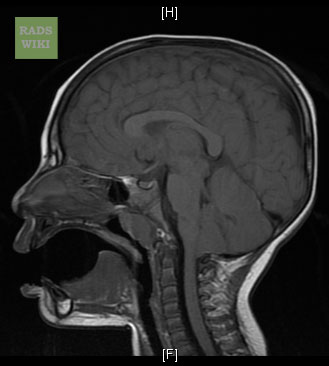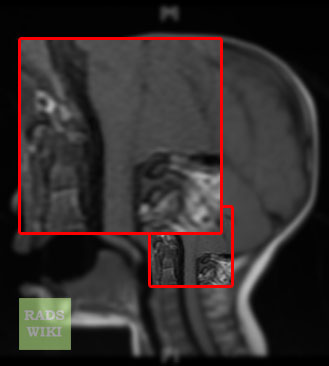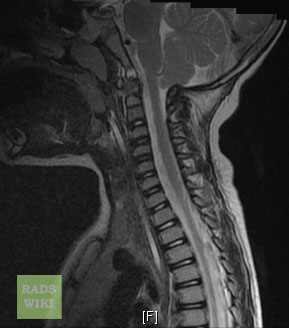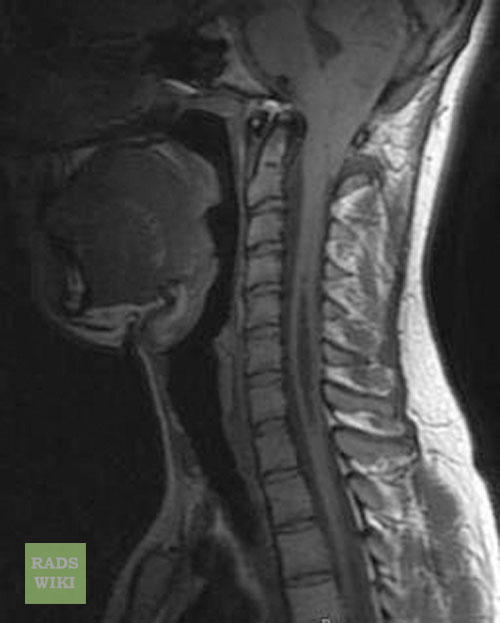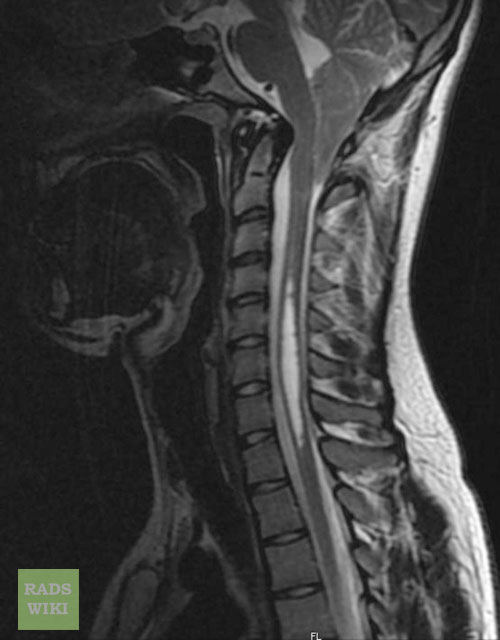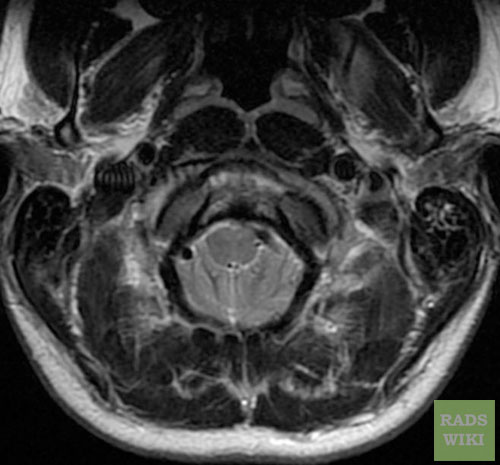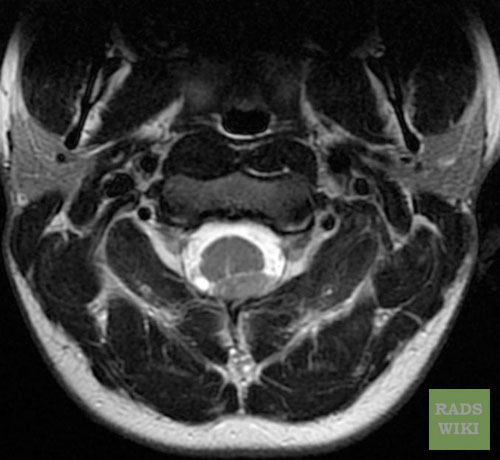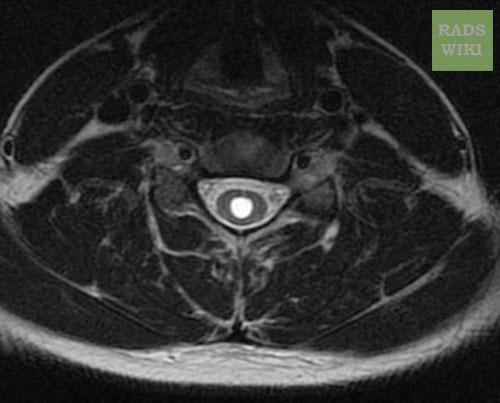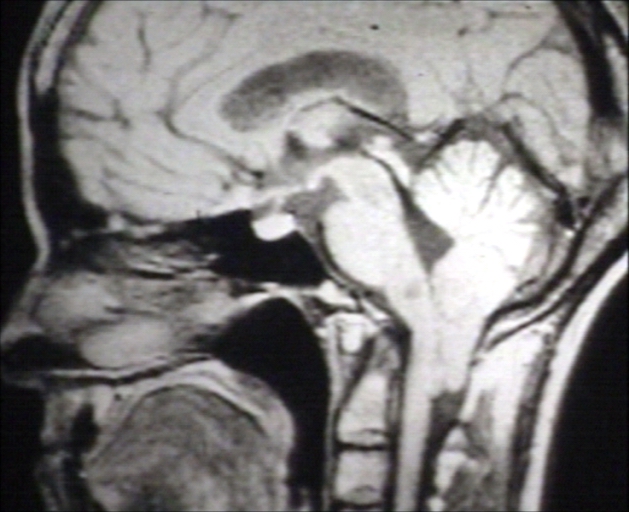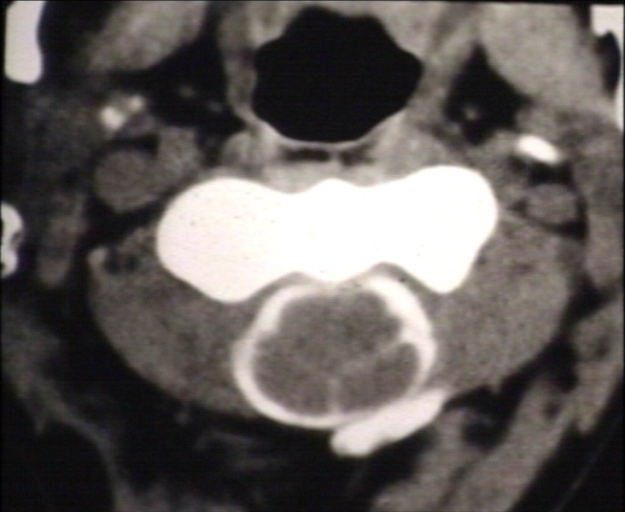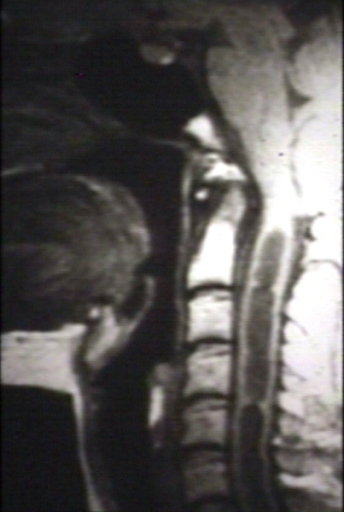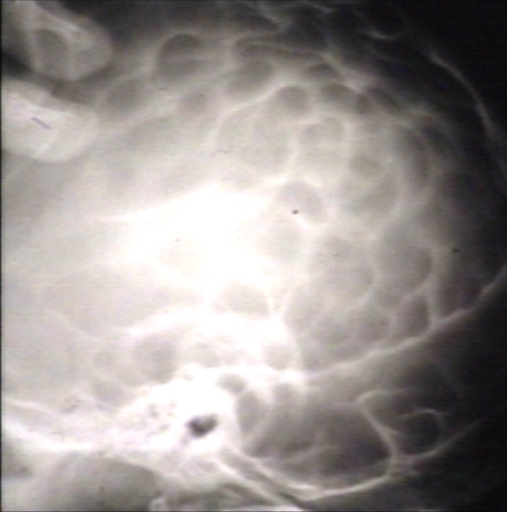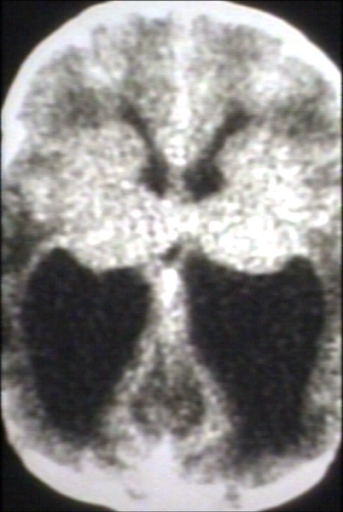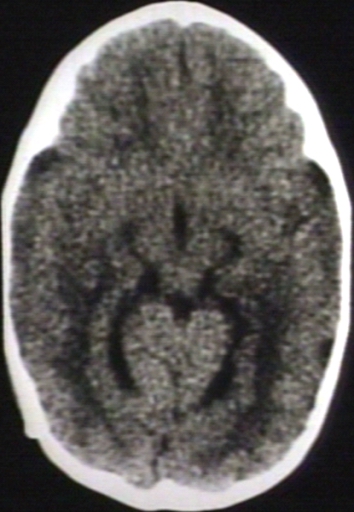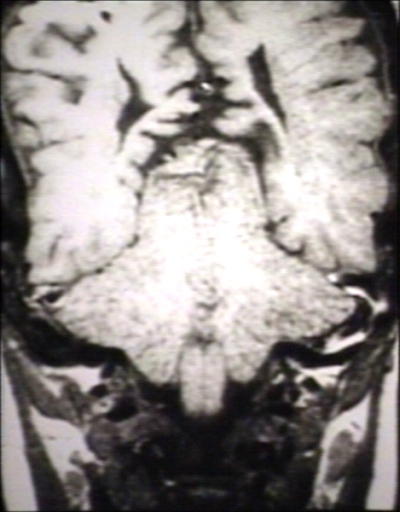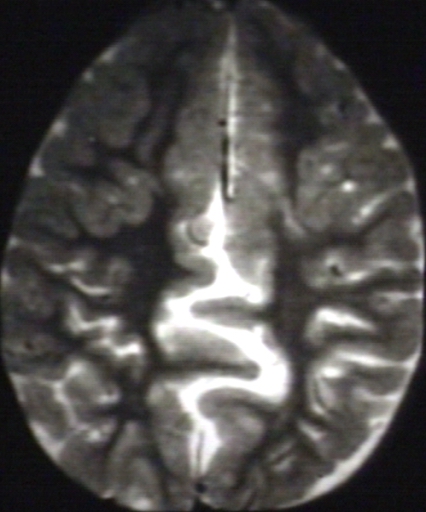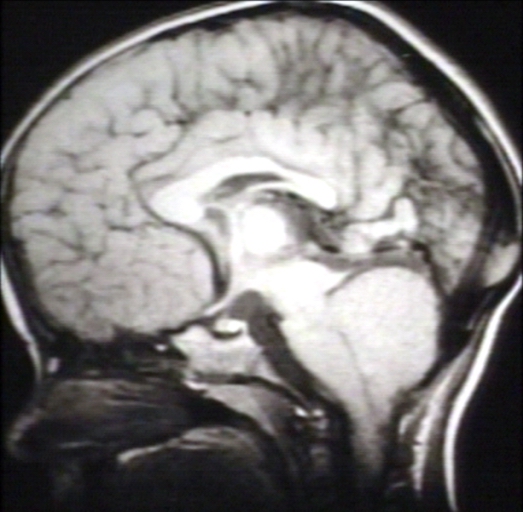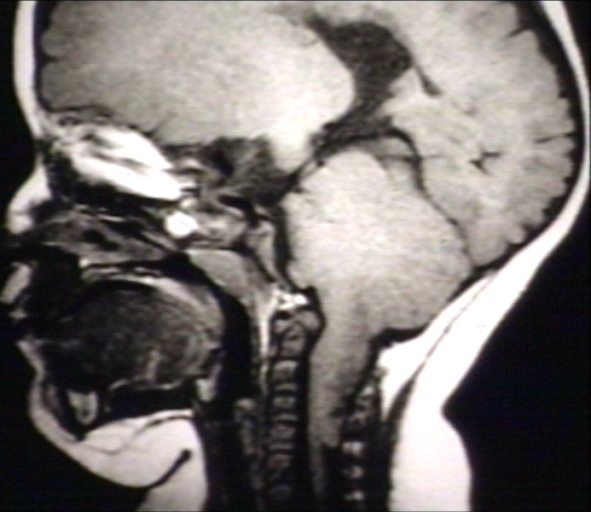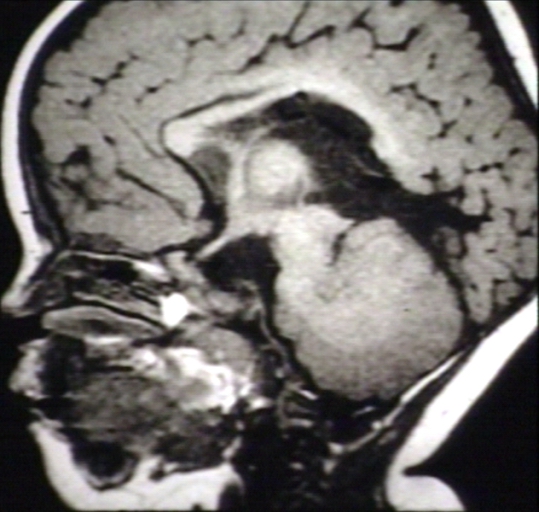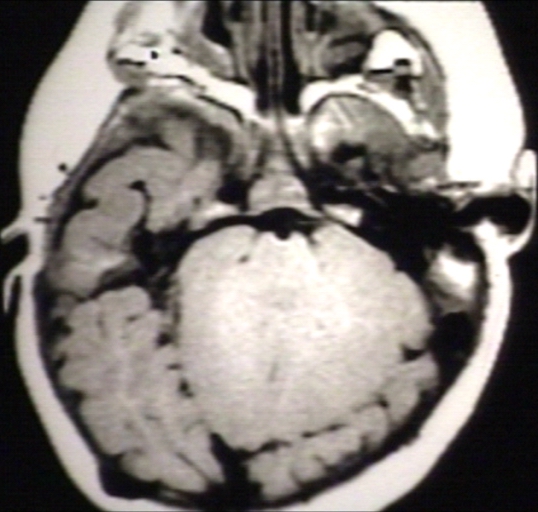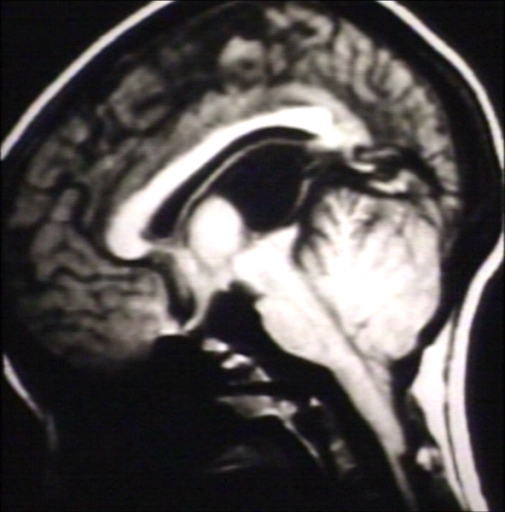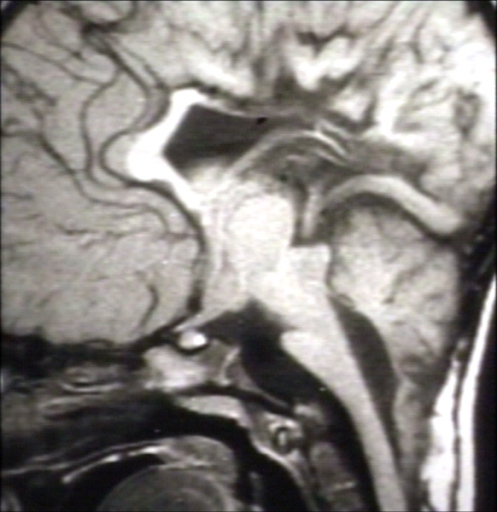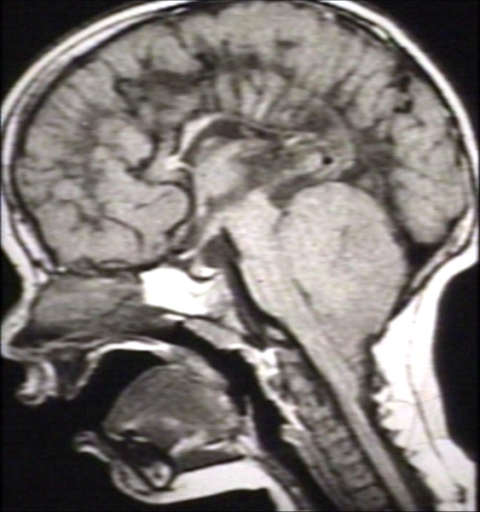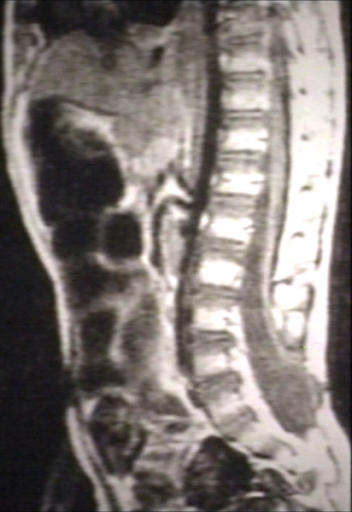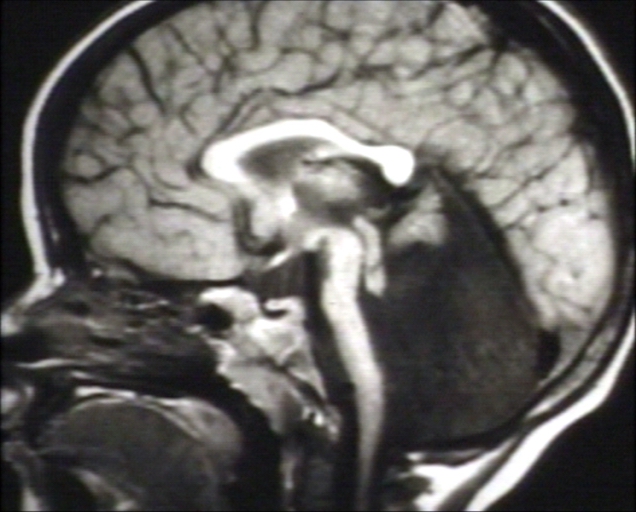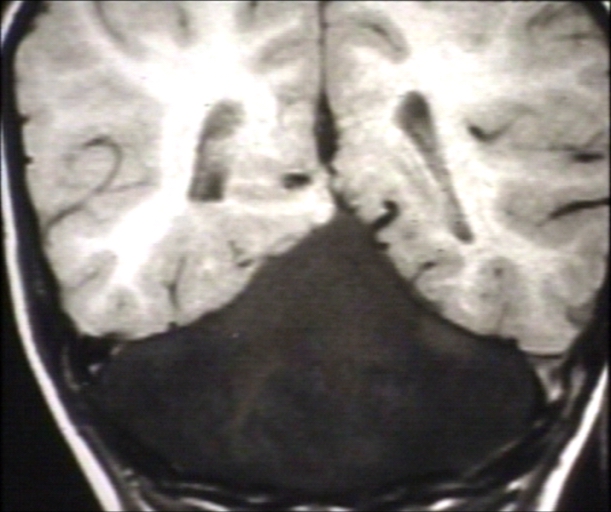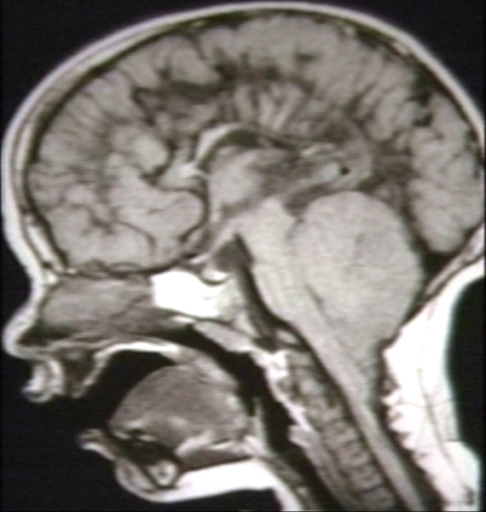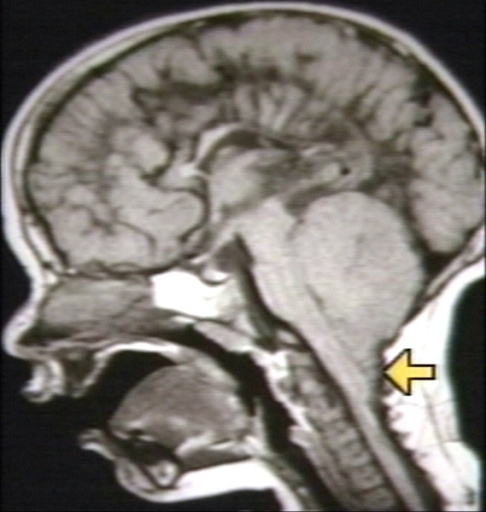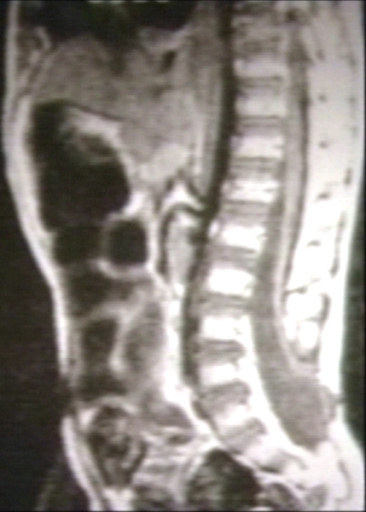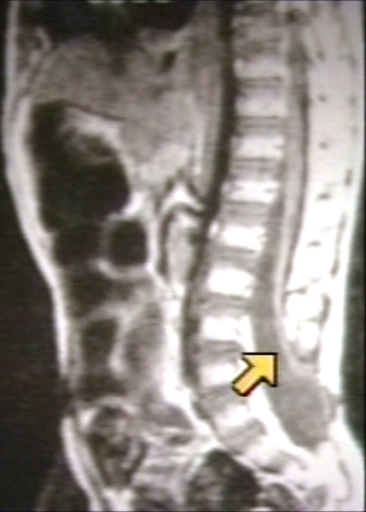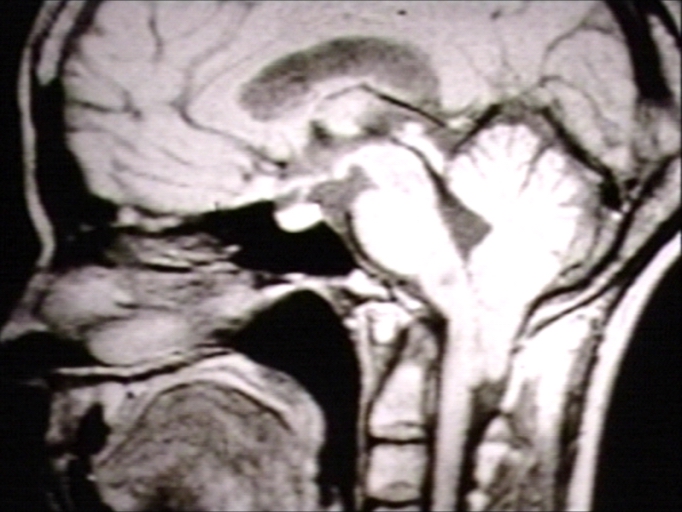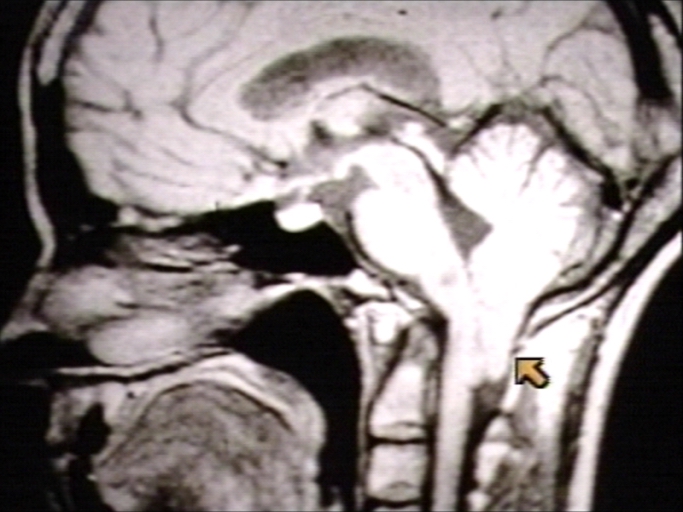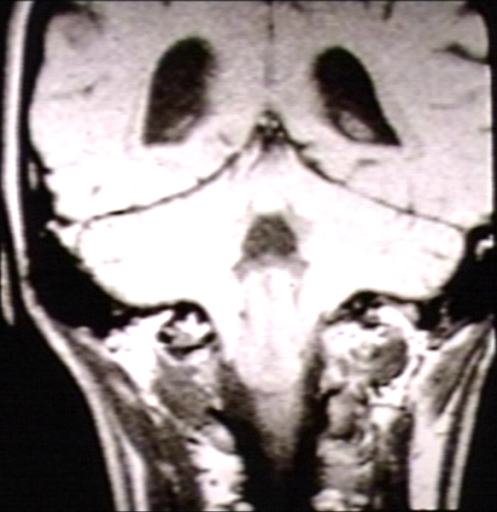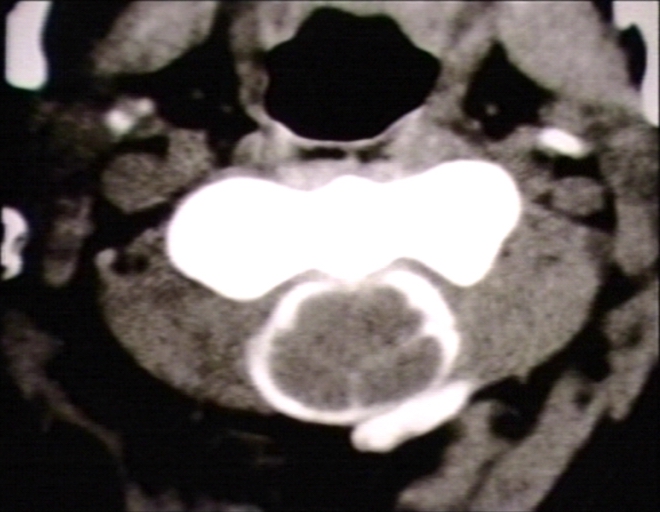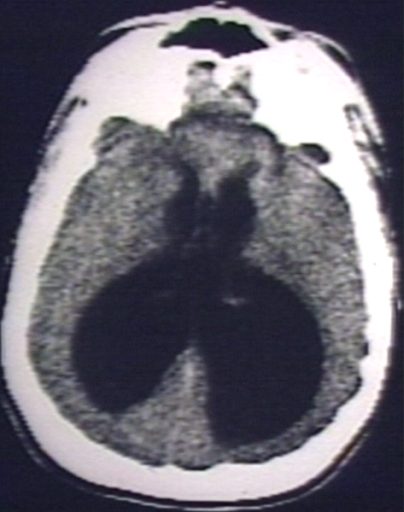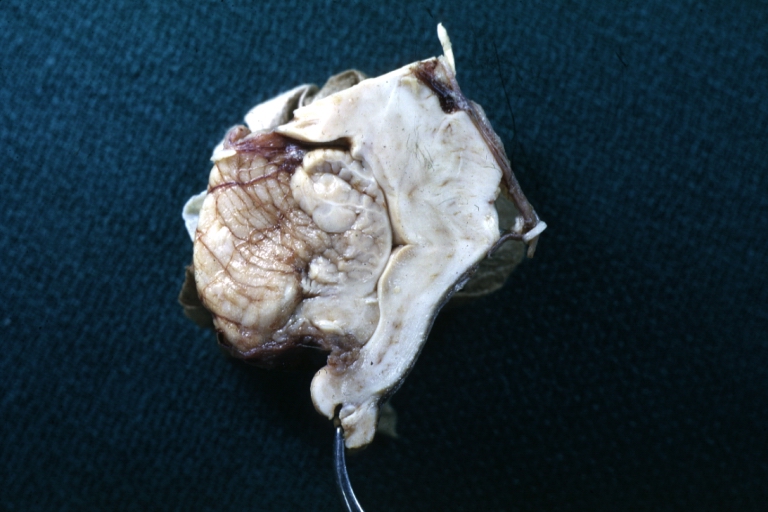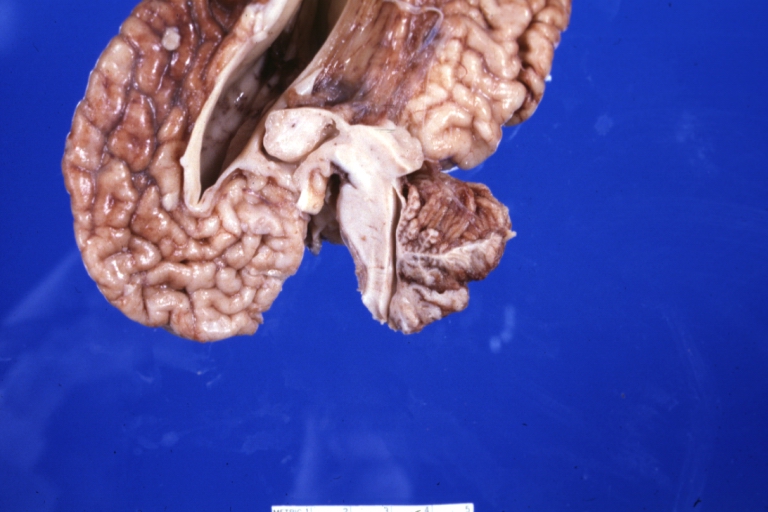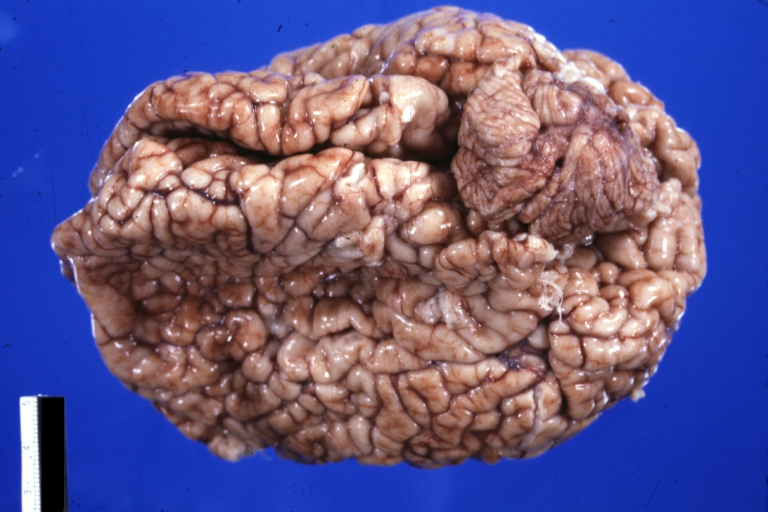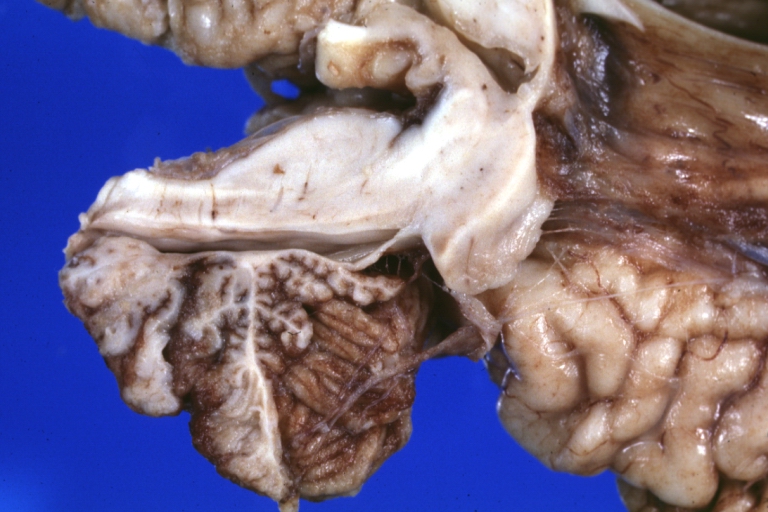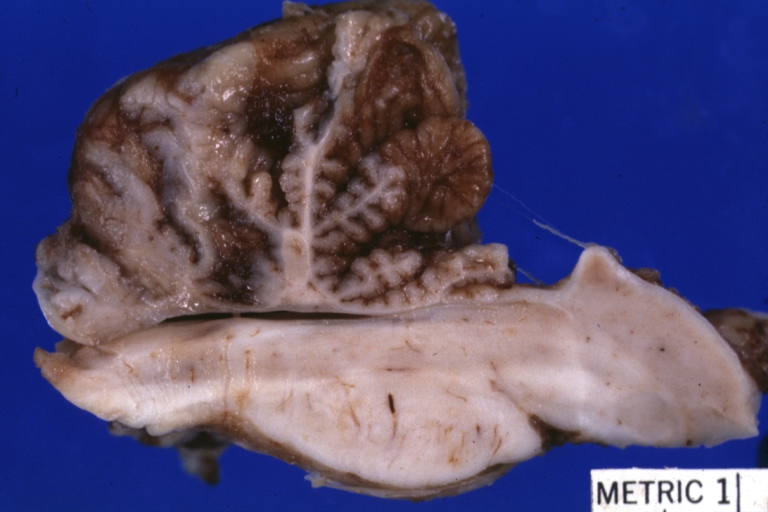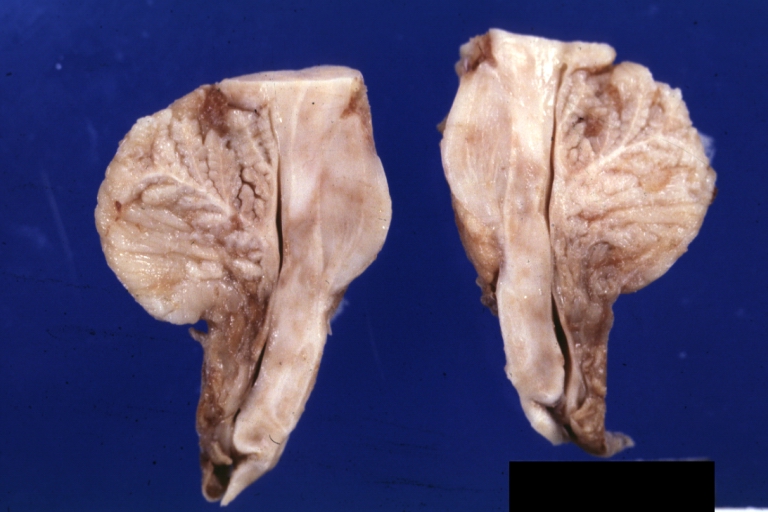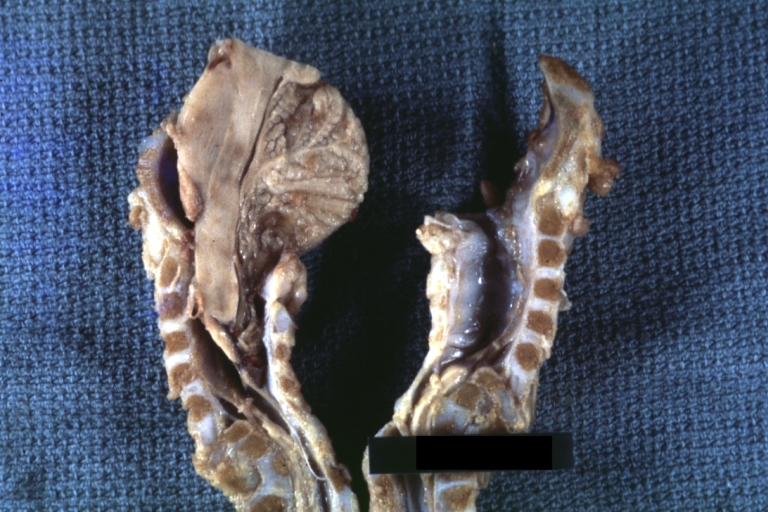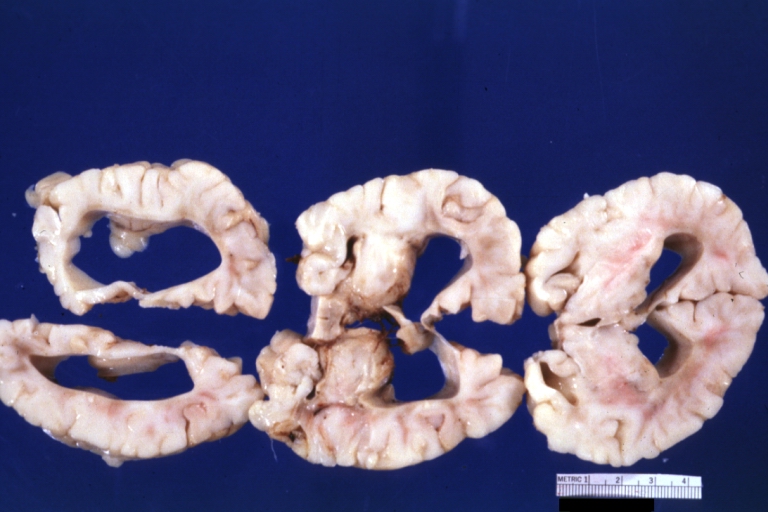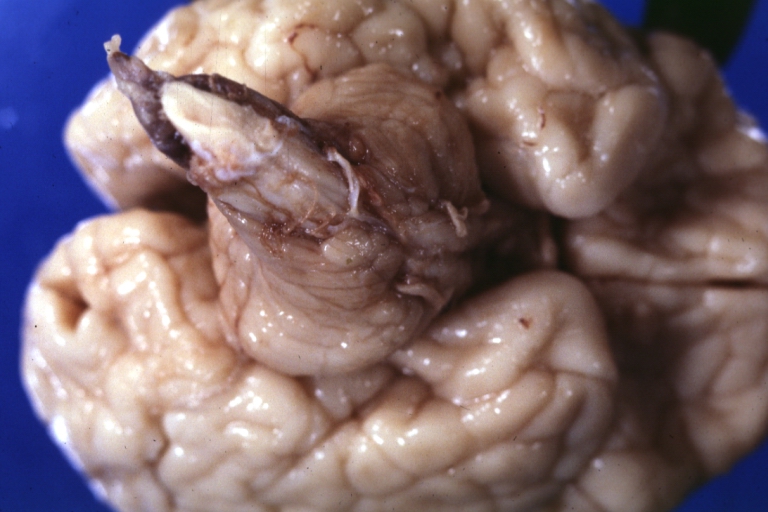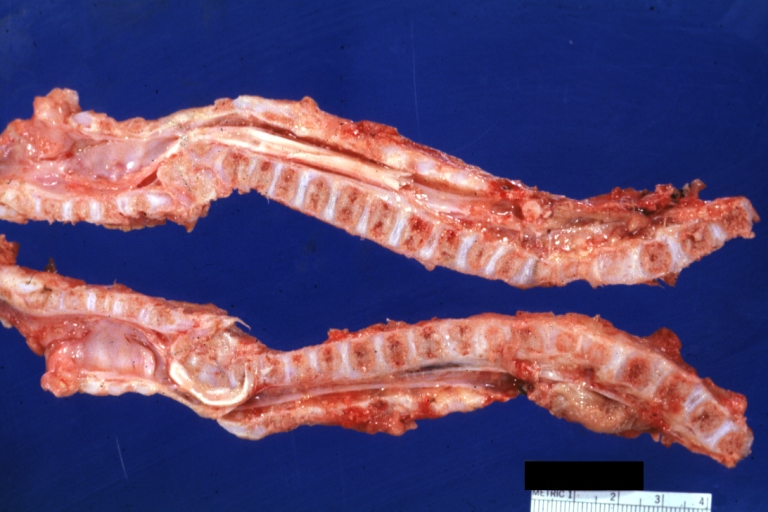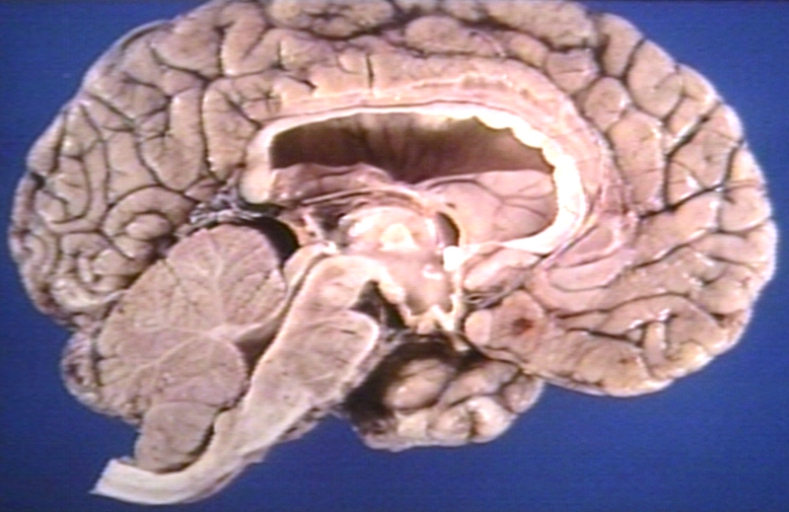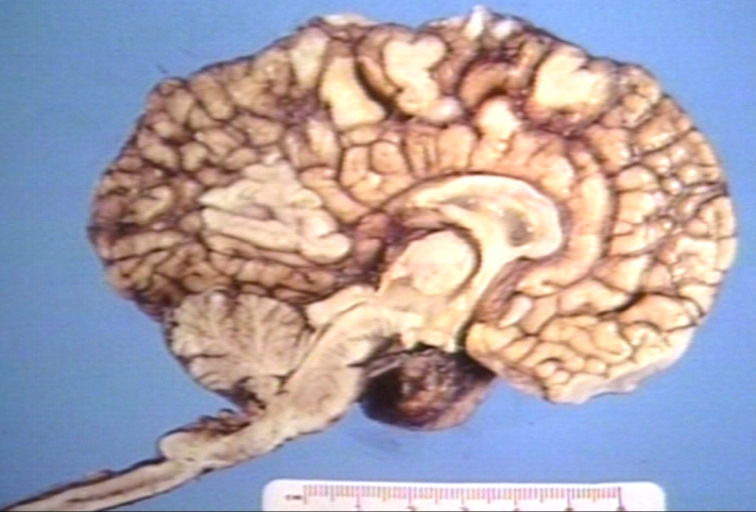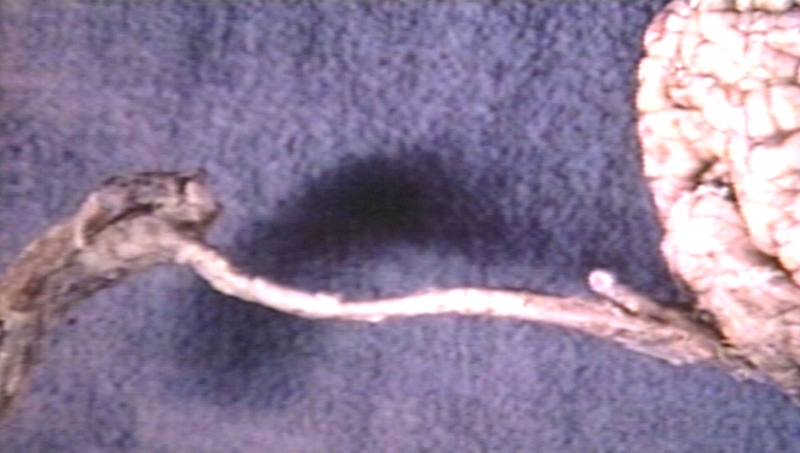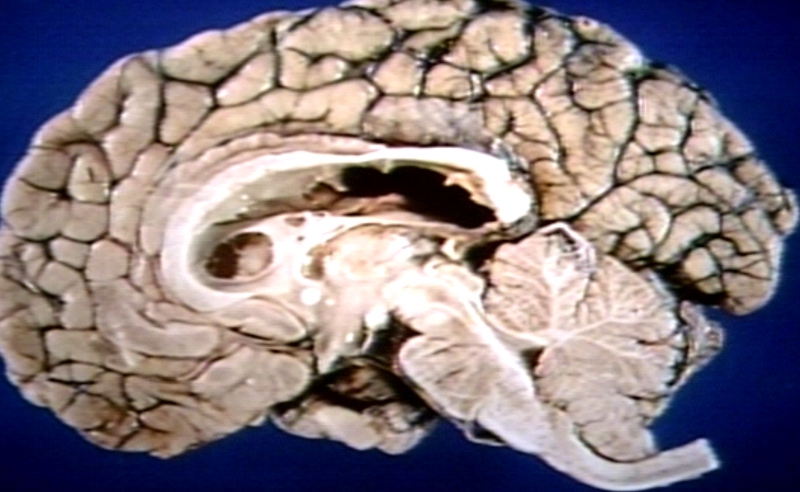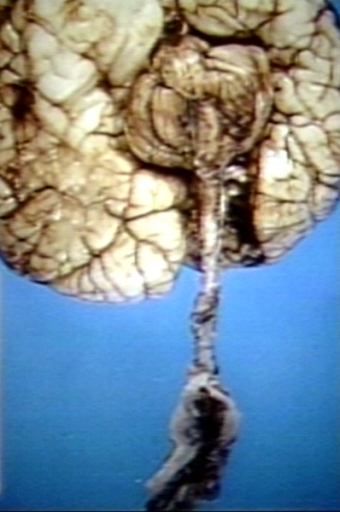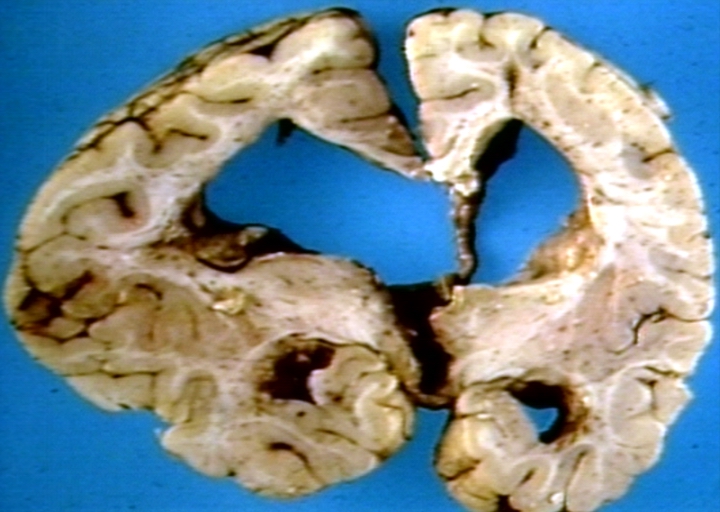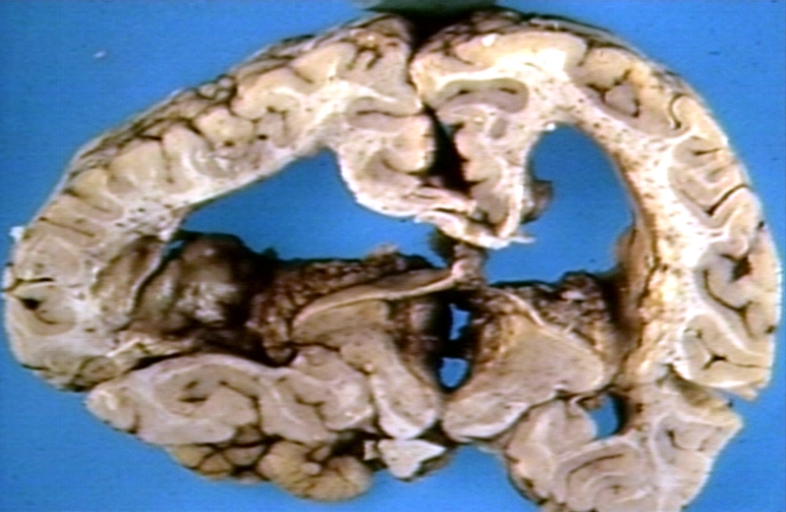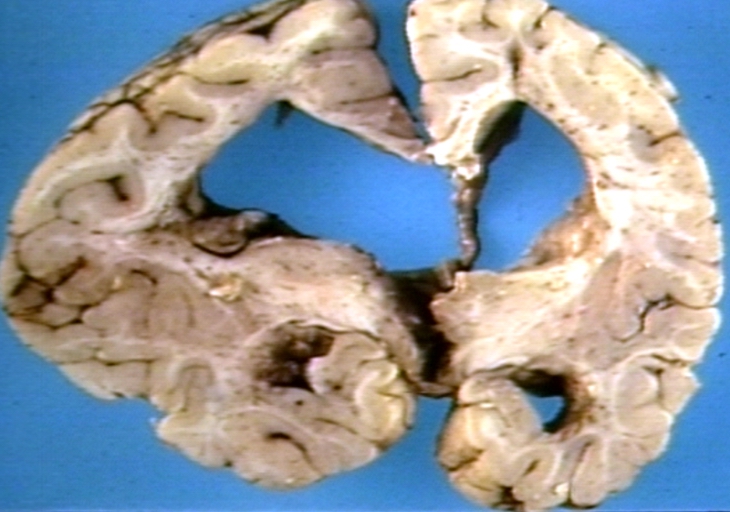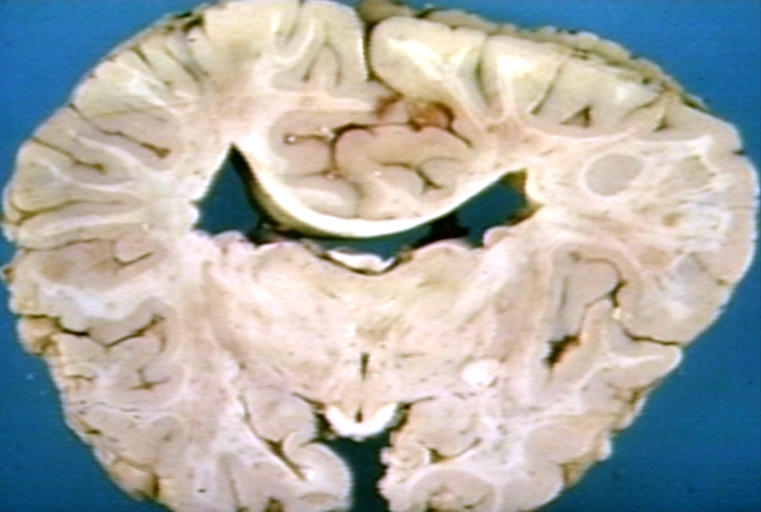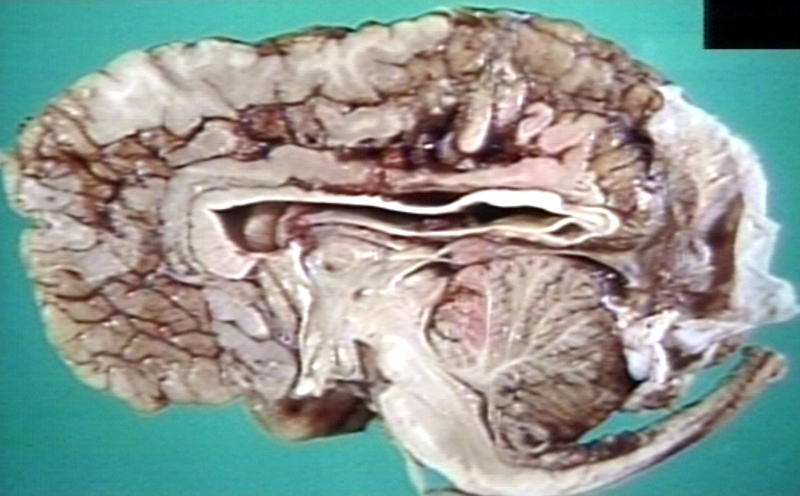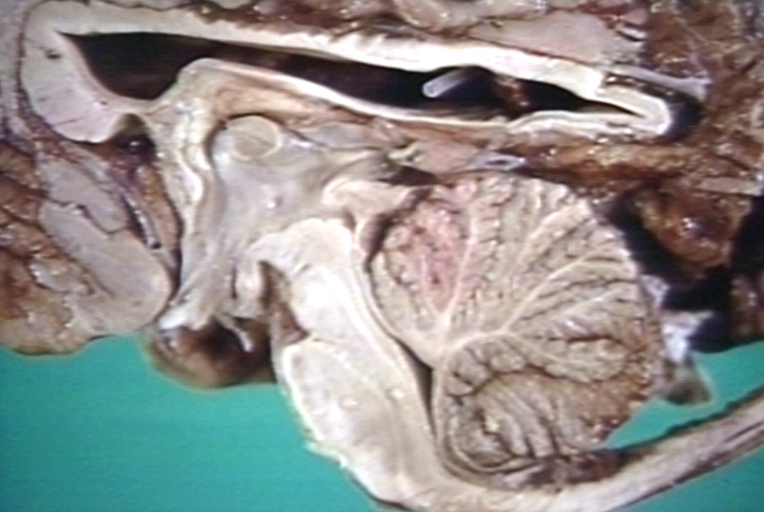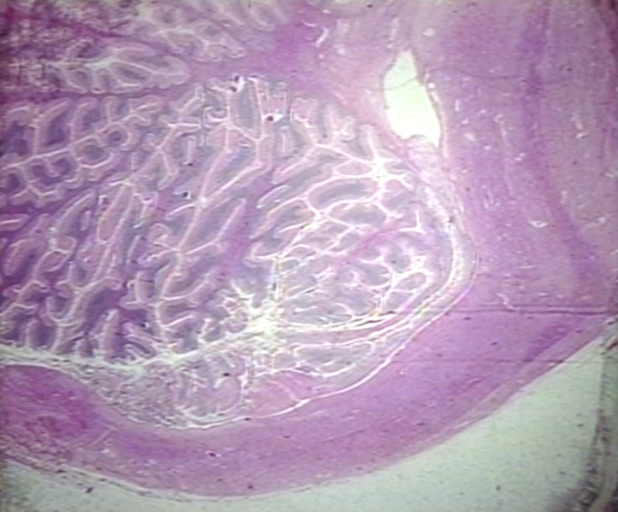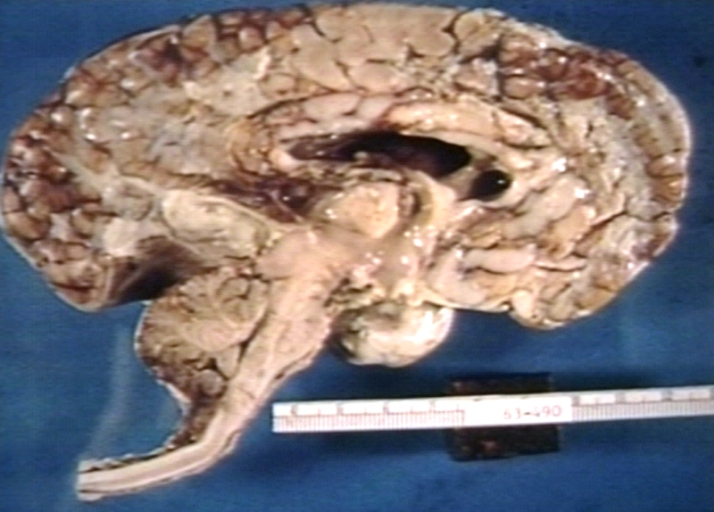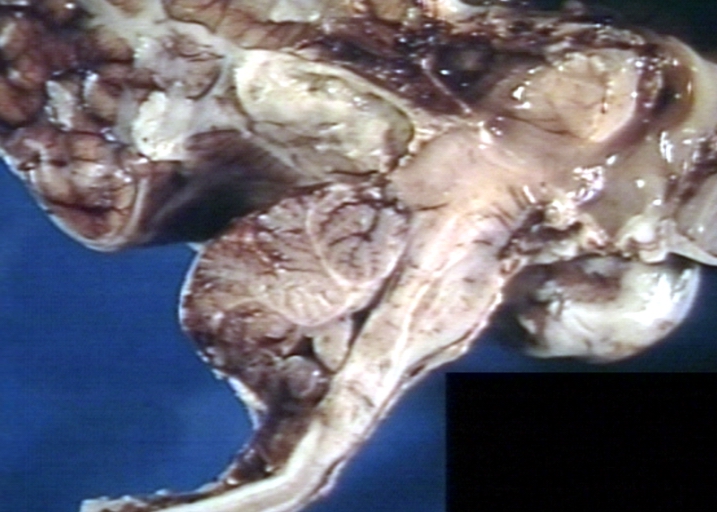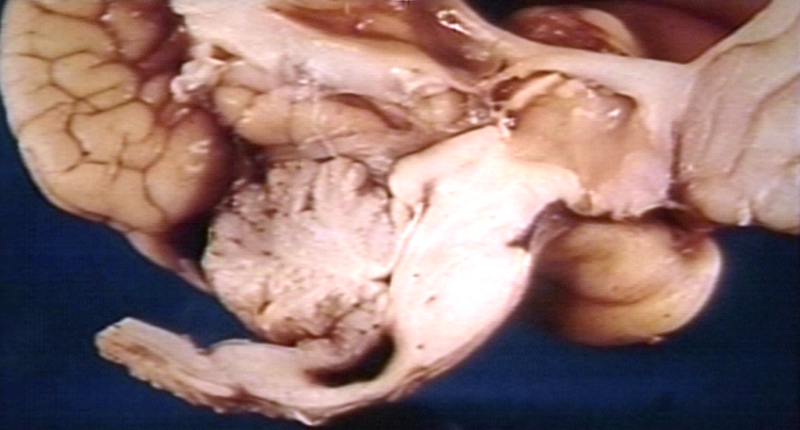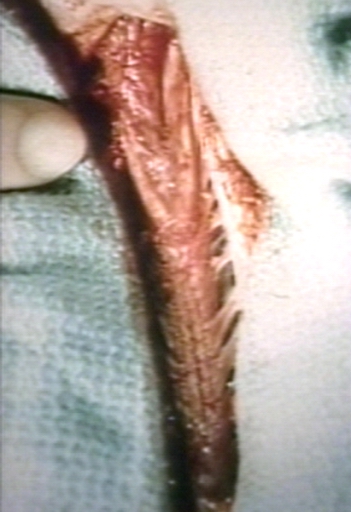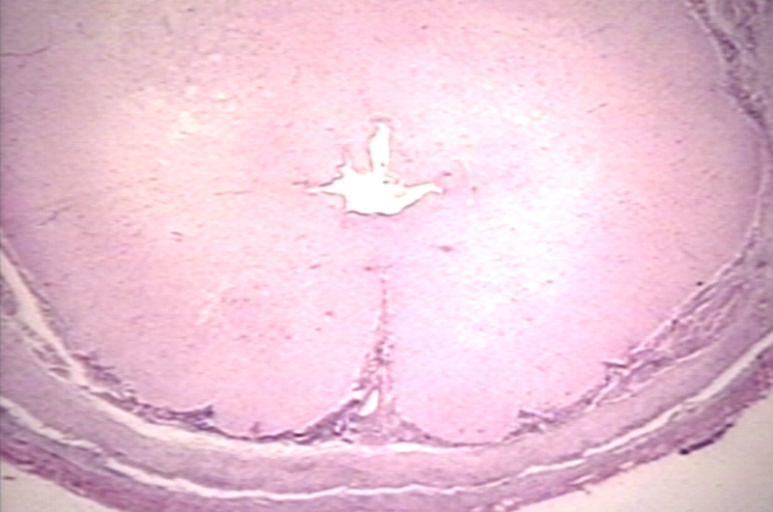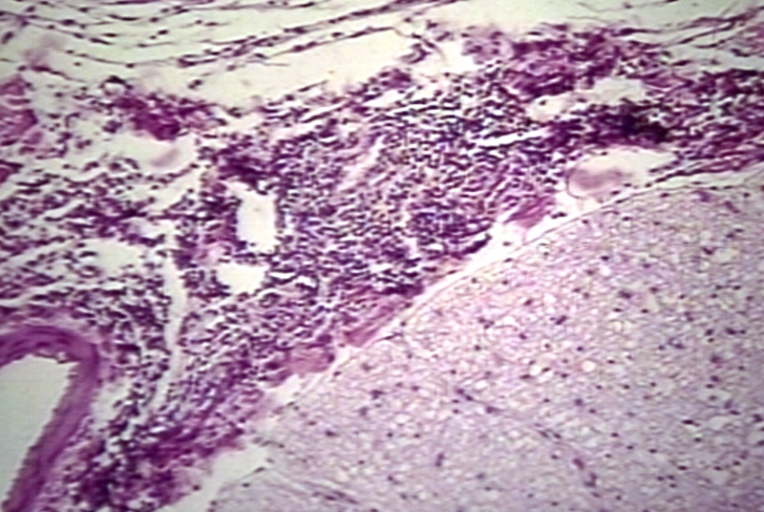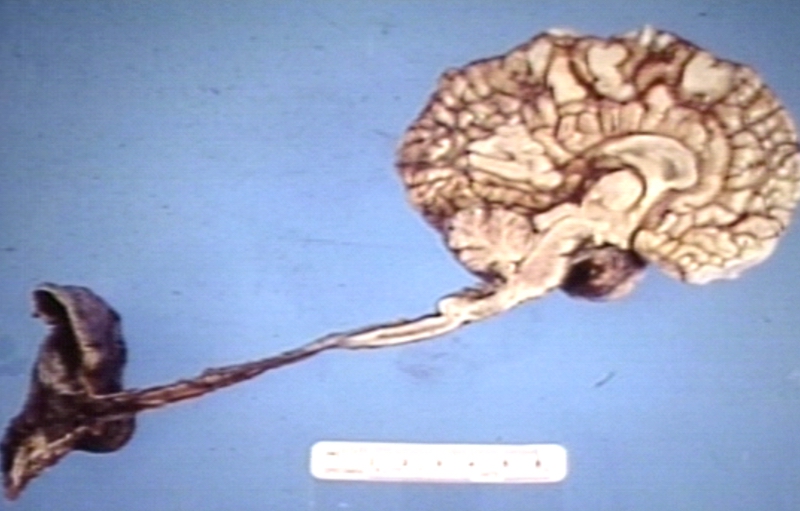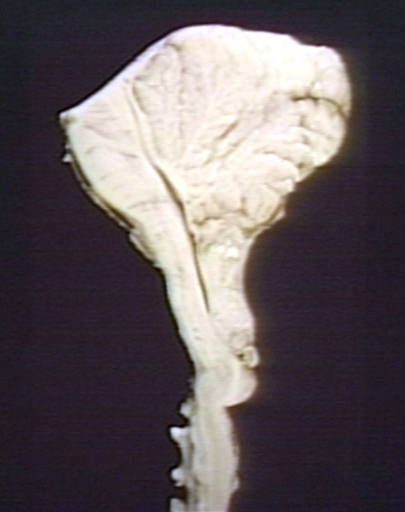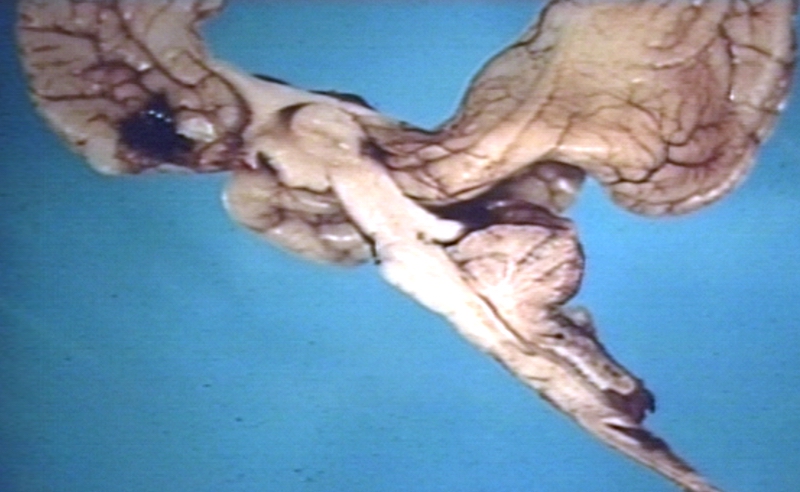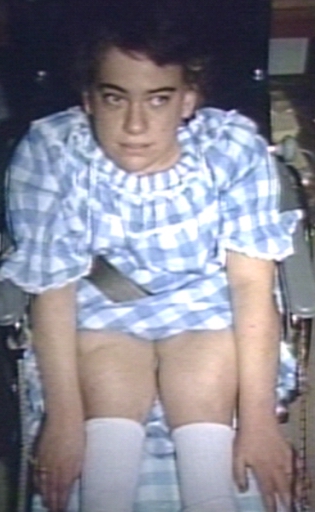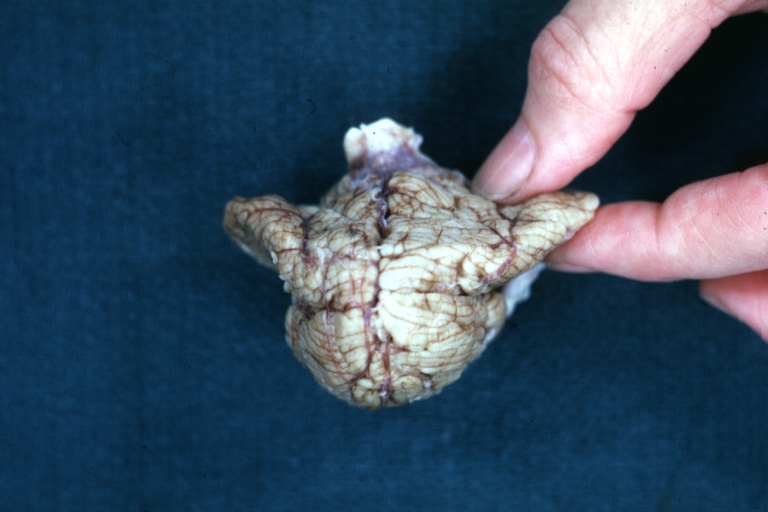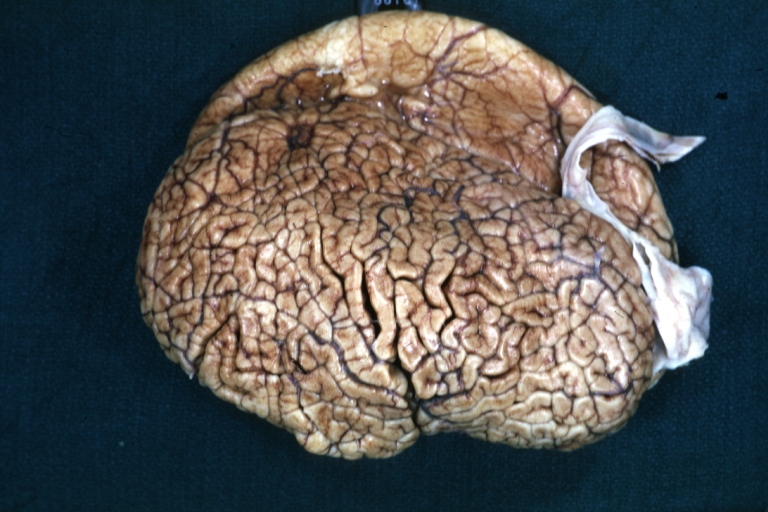Arnold-Chiari malformation
| Arnold-Chiari malformation | |
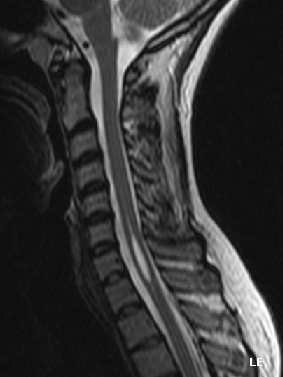 | |
|---|---|
| An uncollapsed syrinx (before surgery). | |
| ICD-10 | Q07.0 |
| ICD-9 | 741.0 |
| OMIM | 207950 |
| DiseasesDB | 899 |
| MeSH | D001139 |
Editor-In-Chief: C. Michael Gibson, M.S., M.D. [1]
Overview
Arnold-Chiari malformation, sometimes referred to as Chiari malformation or ACM, is a congenital anomaly of the brain.
Arnold-Chiari Malformation II occurs in almost all children born with both spina bifida and hydrocephalus, but ACM I is typically seen in children and adults without spina bifida. The scale of severity is rated I - IV, with IV being the most severe. [1] [2] [3]
Cause
The cerebellar tonsils are elongated and pushed down through the opening of the base of the skull (see foramen magnum), blocking the flow of cerebrospinal fluid (CSF).
The brainstem, cranial nerves, and the lower portion of the cerebellum may be stretched or compressed.
Therefore, any of the functions controlled by these areas may be affected. The blockage of CSF flow may also cause a syrinx to form, eventually leading to syringomyelia. Many sufferers turn to the Chiari Institute in Long Island, NY for specialized medical attention and medication.
Presentation
In infants, the most common symptoms are stridor and swallowing difficulties. In older children, upper (and lower as age marches on) limb weakness and breathing difficulties may occur. Patients may experience no symptoms or remain asymptomatic until early adulthood, at which point they will often experience quick onset severe headaches and neck pain. Fatigue, dizziness, vertigo, neuropathic pain, pain at the point of tethering, visual disturbances, difficulty swallowing, ringing in the ears, sleep apnea, impaired fine motor skills, muscle weakness, and palpitations and excessive clearing of the throat with no obstructions are other common symptoms. Because of the complex combination of symptoms and the lack of experience with ACM1 had by many, even outstanding neurologists and neurosurgeons, many patients are frequently misdiagnosed.
Some patients may go an entire lifetime without having noticeable symptoms. Or, symptoms can be minimal, then turn severe suddenly due to head trauma which alters the condition of the spine, brain, or cerebellar tonsils and begins to cause more difficulties...
Diagnostic Studies
- Radiographs may demonstrate associated abnormalities of the skull base.
- CT may demonstrate hydrocephalus, herniated cerebellar tonsils, and a flattened spinal cord. Rarely will CT show a syrinx.
- MRI is the imaging modality of choice to evaluate for a Chiari I malformation. MRI findings:
- Cerebellar tonsillar herniation
- Wedge shaped tonsils
- Syringohydromyelia
- Small posterior fossa
- Obstructive hydrocephalus
- Brainstem anomalies
- Tonsillar displacement is measured from the basion-opisthion line on a sigittal image.
- Herniation is usually at least 5mm, though patients with 3-5mm herniation may also have the malformation.
- MRI CSF flow studies may prove to be helpful and are currently under investigation.
Patient #1
Images shown below are courtesy of RadsWiki and copylefted
Patient #2
Images shown below are courtesy of RadsWiki and copylefted
Other Radiologic Findings
-
Brain: Arnold Chiari I; T1 (MRI)
-
Brain CT: Arnold Chiari I with Intrathecal Contrast; WC
-
Brain: Arnold Chiari I, with Hydromyelia of Cervical Spinal Cord; T1 (MRI)
-
Skull: Arnold Chiari II, Skull with Luckenschadel (Plain Film)
-
Brain: Arnold Chiari II, Hydrocephalus (CT)
-
Brain: Arnold Chiari II, 6 months Post-Shunt (CT)
-
Brain: Arnold Chiari II, with Towering of The Cerebellum and Wide Tentorial Incisure; T1 (MRI)
-
Brain: Arnold Chiari II, with Fenestrated Falx Cerebri and Interdigitating Gyri; T2 (MRI)
-
Brain: Arnold Chiari II, with Tectal Beaking and Large Massa Intermedia and Stenogyria; T1 (MRI)
-
Brain: Arnold Chiari Type II with Medullary Spur and Kink (MRI)
-
Brain: Arnold Chiari II, with Hypoplastic Corpus Callosum; T1 (MRI)
-
Brain: Arnold Chiari II, with Cerebellar Hemispheres that Creep Anteriorly Around the Brain Stem; T1 (MRI)
-
BRAIN: ARNOLD CHIARI II (MRI)
-
BRAIN: ARNOLD CHIARI II WITH ELONGATED FOURTH VENTRICLES AND STENOGYRIA; T1 (MRI)
-
BRAIN: ARNOLD CHIARI II WITH HYPOPLASTIC CORPUS CALLOSUM AND STENOGYRIA; T1 (MRI)
-
BRAIN: ARNOLD CHIARI II WITH REPAIRED MYELOMENINGOCELE AND TETHERED SPINAL CORD; T1 (MRI)
-
BRAIN: ARNOLD CHIARI TYPE IV; T1 (MRI)
-
BRAIN: ARNOLD CHIARI TYPE IV; T1 (MRI)
-
BRAIN: ARNOLD CHIARI MALFORMATION II; 1/2 PCMC (MRI)
-
BRAIN: ARNOLD CHIARI MALFORMATION II, HERNIATED CEREBELLAR TONSIL; 1/2 PCMC - ARROW (MRI)
-
SPINAL CORD: ARNOLD CHIARI MALFORMATION II; 2/2 PCMC (MRI)
-
SPINAL CORD: ARNOLD CHIARI MALFORMATION II; 2/2 PCMC - ARROW (MRI)
-
BRAIN: ARNOLD CHIARI MALFORMATION; 1/3 T2 (MRI)
-
BRAIN: ARNOLD CHIARI MALFORMATION; 1/3 - ARROW T2 (MRI)
-
BRAIN: ARNOLD CHIARI MALFORMATION; 2/3 T2 (MRI)
-
SPINAL CORD: ARNOLD CHIARI MALFORMATION; 3/3 (CT)
-
BRAIN: ARNOLD CHIARI MALFORMATION (CT)
Pathological Findings
-
Brain: Arnold-Chiari Malformation: Gross fixed tissue sagittal section brain stem
-
Brain: Arnold Chiari Malformation: Gross fixed tissue sagittal section cerebrum brainstem and cerebellum
-
Brain: Arnold Chiari Malformation And Polygyria: Gross fix tissue external view
-
Brain: Arnold Chiari Malformation: Gross fixed tissue sagittal section brainstem close-up
-
Brain: Arnold Chiari Malformation: Gross fixed tissue brain stem sagittal section close-up
-
Brain: Arnold Chiari Malformation: Gross fixed tissue sagittal section brain stem and cerebellum
-
Brain: Arnold Chiari Malformation: Gross fixed tissue sagittal section brain stem cerebellum and spinal column
-
Brain: Hydrocephalus Secondary To Arnold Chiari Malformation: Gross fixed tissue three coronal sections cerebral hemispheres
-
Brain: Arnold Chiari Malformation: Gross fixed tissue cerebellum and brainstem
-
Spinal cord: Malformation Vertebral Bodies: Gross natural color sagittal section spinal column with malformation in region C7 T1 associated with Arnold Chiari malformation
-
Brain: Arnold Chiari Malformation; with Hydrocephalus, Type I
-
Brain: Arnold Chiari Malformation; Type II
-
Brain: Arnold Chiari Type II with Meningomyelocele
-
Brain: Arnold Chiari Malformation; Mid Sagittal
-
Brain: Arnold Chiari Malformation with Myelocele
-
Brain: Arnold Chiari Malformation with Hydrocephalus
-
Brain: Arnold Chiari Malformation with Hydrocephalus
-
Brain: Arnold Chiari Malformation
-
Brain: Arnold Chiari Malformation
-
Brain: Arnold Chiari Malformation
-
Brain: Arnold Chiari Malformation, a close up view
-
Brain: Arnold Chiari Malformation; Tonsilar Herniation of Cerebellum Compressing Medulla
-
Brain: Arnold Chiari Malformation; Meningomyelocele, Type II, Meningitis
-
Brain: Arnold Chiari Malformation, Type II; Meningomyelocele, Meningitis, Close-up of Previous one
-
Brain: Arnold Chiari Malformation, Intramedullary Hemorrhage
-
Brain: Arnold Chiari Malformation, Type II
-
Spinal Cord: Arnold Chiari Malformation; Type II, Meningomyelitis
-
Spinal Cord: Arnold Chiari Malformation; Type II, Meningomyelitis
-
Brain: Arnold Chiari Malformation
-
Brain: Arnold Chiari Malformation; Note Z-Shaped Kink in Cervical Spinal Cord
-
Brain: Arnold Chiari Malformation with Hydrocephalus
-
Skin: Myelomeningocele with Hydrocephalus; Arnold Chiari; Note Underdevelopment of Legs
-
Brain: Cerebellum Arnold Chiari: Gross fixed tissue flattened cerebellum
-
Brain: Polymicrogyria: Gross fixed brain lateral view of left cerebral hemisphere case of Arnold Chiari cerebellum
Treatment
Once these "onset of symptoms" occurs, the most frequent treatment is decompression surgery, in which a neurosurgeon seeks to open the base of the skull and through various methods unrestrict CSF flow to the spine.
This treatment is under observation and review. Decompression is a very taxing surgical procedure and is now, in some circles, disdained in lieu of tethered cord detachment at the base of the spine. Some neurological surgeons find that detethering the spinal cord relieves the compression of the brain against the skull opening (foramen magnum) obviating the need for decompression surgery and associated trauma. It should be noted that the alternative spinal surgery is not without risk.
History
An Austrian pathologist, Hans Chiari, first described these hindbrain malformations in the 1890s. A colleague of Professor Chiari, Dr. Julius Arnold later contributed to the definition of the condition, and students of Dr. Arnold suggested the term "Arnold-Chiari malformation" to henceforth refer to the condition.[4]
References
- ↑ Barkovich AJ, Wippold FJ, Sherman JL, Citrin CM. Significance of cerebellar tonsillar position on MR. AJNR Am J Neuroradiol. 1986 Sep-Oct;7(5):795-9.
- ↑ Haughton VM, Korosec FR, Medow JE, Dolar MT, Iskandar BJ. Peak systolic and diastolic CSF velocity in the foramen magnum in adult patients with Chiari I malformations and in normal control participants. AJNR Am J Neuroradiol. 2003 Feb;24(2):169-76.
- ↑ Elster A, Chen M. Chiari I malformations: clinical and radiologic reappraisal. Radiology. 1992; 183:347-353.
- ↑ Template:WhoNamedIt
Template:Congenital malformations and deformations of nervous system Template:SIB
ca:Malformació d'Arnold-Chiari de:Chiari-Malformation it:Sindrome di Arnold-Chiari
